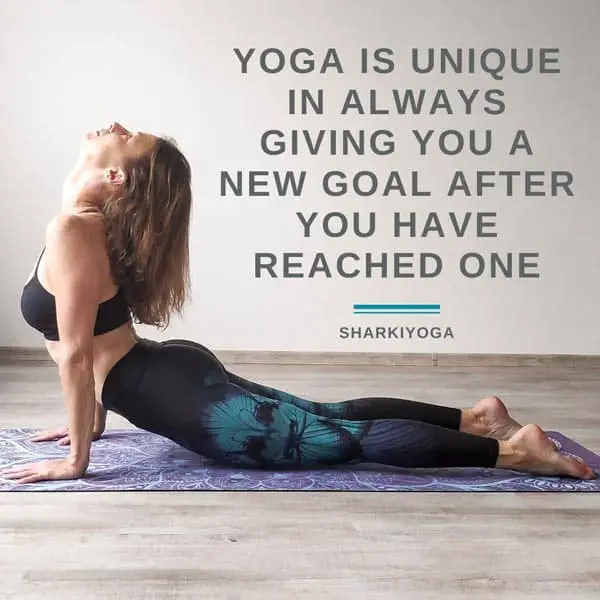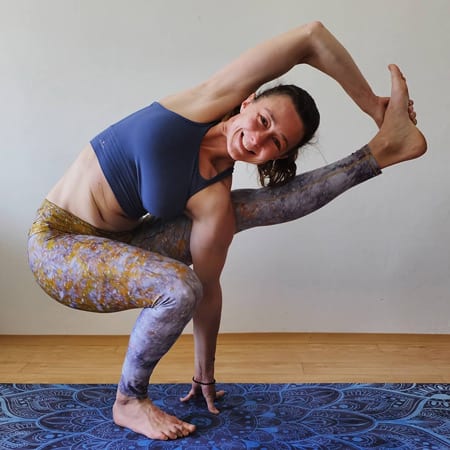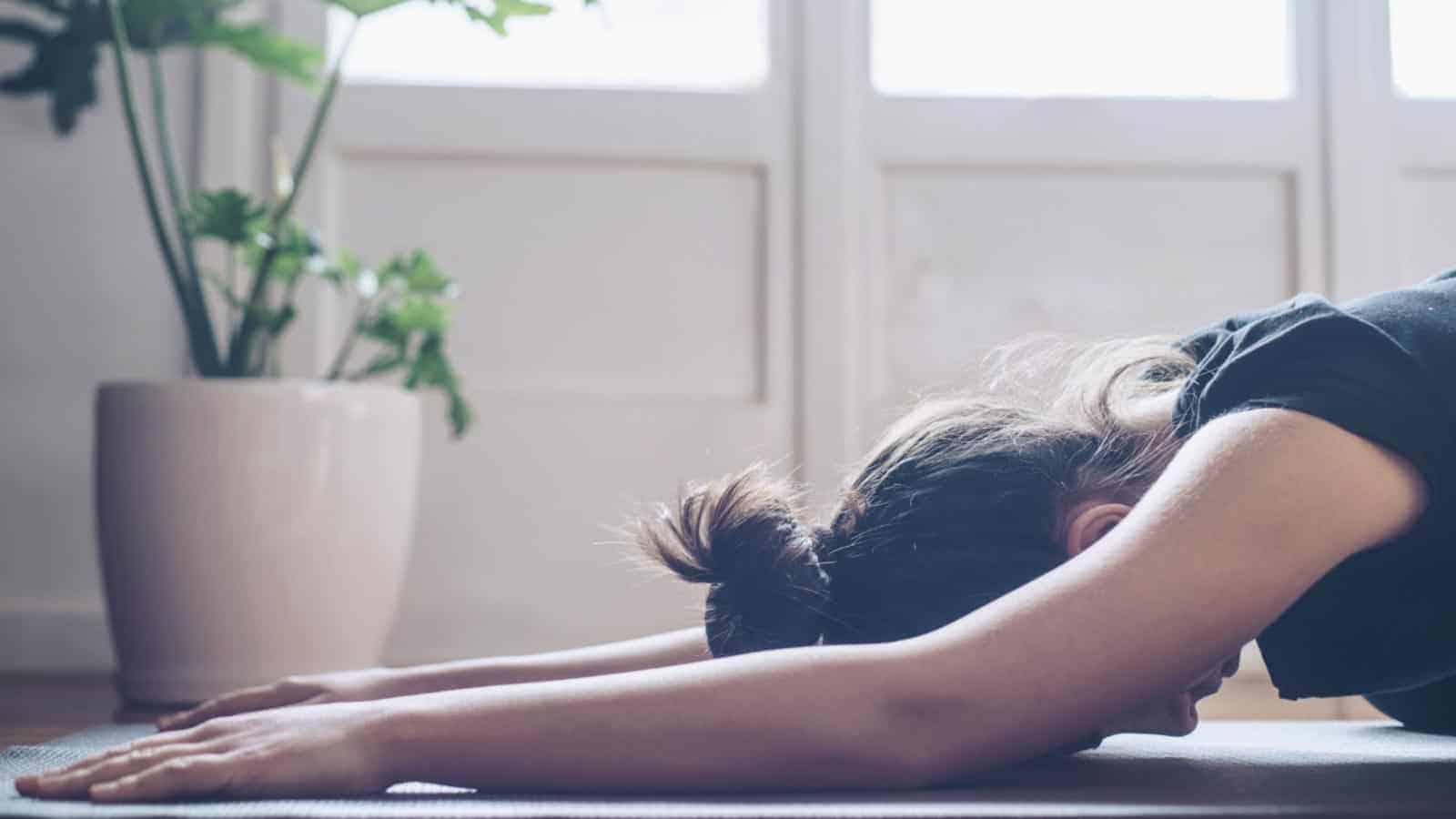The guest article by Czech yoga teacher Sharka
Let me tell you that a few years ago I was asking the same question “What would be the effect of a regular yoga practice?” There are many articles and plenty of information about the benefits of yoga. When you scroll down on Instagram, you will see yoga poses that you didn’t even know existed or even where possible. You can also read about strict disciplines to be followed in books about traditional yoga. All this information can be confusing, right?
The truth is that no one knows what exactly will happen to you when you begin practicing yoga on a regular basis, but every yoga practitioner will tell you that there will be positive changes.
In this article I won’t give you alignment tips or be telling you to practice yoga 5 days a week. I would like this to be a reflection of my journey to serve you as a motivation to find a yoga practice that you will love and that will become sustainable for you.
1. Set your goals, but change them every day
You have heard (or maybe not) Sri K. Pattabhi Jois’phrase “Practice and all is coming”. I understand that it might be difficult to believe this quote when you still find it hard to hold 5 breaths in downward dog, but it makes you feel better – I didn’t want to believe it either, at first.
We tend to have prejudice towards our body, and we tend to assume in which yoga poses we will be feeling good and which yoga poses are not visible for us. The truth is that there is no need to worry about what you will be able to do tomorrow, or ever, because our yoga practice depends on how we feel on that specific day. Every single day your yoga practice will be different, every single day you might want to do different poses. Listen to your body and don’t be afraid to adjust your goals according to how you feel.
A regular yoga practice changes the way we see our body day by day

I could always fold deep, touching the ground was never a problem for me, so I assumed that backbends will be hard for me. At the beginning of my regular yoga practice this mindset actually made me avoid practicing backbends for a good year. I haven’t improved until I started including them to my regular yoga practice.
Now, I can’t tell anymore whether I prefer folds or bends. I love them both. Moving my spine in all directions is something that became so natural and my body misses the range of movement, if it happens that I have to skip my yoga asana practice for a few days.
But there is something even more important that I learnt along the way. Practicing backbends was just one part of the backbend progress! The other part was to remain practicing folds and making sure include twist to release the tensions. I learned that skipping certain asanas when they didn’t feel good on a particular day was important in order to let muscles relax.
Just working on one asana just because we want to improve it, isn’t a good recipe. Do you want to be able to do a wheel pose? Perfect! Work on your cobras, locusts and camels, but always include folds and twists too.
2. The variety of movements benefits your body
There are yoga asanas and movements I assumed I would never ever reach, and they came to me just after a few months. On the other hand, there are yoga poses that I expected to do easily due to my focus on them and I still can’t perform them until today.
Never, not even as a young and flexible girl, I was able to drop back into wheel pose. Some recent tries at the wall made me think that it will take years for me to get there. Then one day, while I was performing a standing backbend, I suddenly thought the mat isn’t far away and I dropped back with ease.
When we work regularly on different yoga poses, our body becomes more flexible, stronger. Without realizing we prepare our body for the poses that we thought we can’t perform and one day – it happens. My advice is – practice different types of yoga or at lease have a list of different yoga asanas which help you to move your entire body. You will notice that adjusting the goals to who you become along the journey will become natural. Yoga is unique in always giving you a new goal after you have reached one.
The good & the bad side of the body
There is duality in our body. Each muscle has an antagonist muscle, which in practice means that focusing on just one side of the spectrum can lead to issues with the other side. All of us enter physical yoga practice with smaller or bigger dis-balances, because we naturally prefer one side of the body in many daily activities. But the right & left approach isn’t enough to describe it and, in a way, thinking about the good and the bad side of your body can cause more harm than you expect.
It wasn’t until I discovered the existence of the spiral myofascial line (“myofascial lines” are lines of connective tissue that run through out the body. These lines help the body to move as a unit) to understand my body’s dis-balances. And it wasn’t until I started to fully believe in the intelligence of my body and until I gave up the concentrated focus on “improving my bad side” that my posture started to improve rapidly and the differences of the sides started to vanish. Flowing, surrendering, and feeling good in the movement is thousand times more effective than biting your lips in prolonging those holds on the bad side.
3. Learn to ‘let it go’
Everyone will tell you to let go of your believes about your body, misconceptions or fears, and it’s completely normal that you won’t be able to do so at the beginning of your yogic journey. Each of us must find our own way “of letting go” and while some of us will find comfort in understanding own body through anatomical books, others will release old believes through breathing techniques and meditation.
During your journey, you might discover that the duality of thinking will influence your approach to yoga as well. You will probably be inclined to see yourself as either flexible or strong, or in the worse case you will think about your body as stiff and weak. Just know that all of it is just a current state of mind! The more regular you are in your yoga practice, the less duality in thinking there will be. This knowledge will help you to remain regular with your practice.
4. Connection between the mental and the physical
Let me ask you this question: What do you imagine when someone tells you yoga is not just a physical activity?
At the beginning of my yoga practice, I knew there was the breathing, the relaxation and meditation. Sitting with your conscious breath for five minutes was more difficult than performing a yoga asanas. Bu it is a different kind of difficult.
In our daily life we tend to compete with others and we strongly believe that our goals can be achieved only through our hard work. In yoga, sometimes the harder you try the farther the goal seems.

According to traditional understanding of yoga there are 8 limbs defined. You can view them as stages or parts of the whole system of yoga. The journey to pranayama (conscious breathing) leads through asana (physical yoga poses). There is pratyahara (withdrawal of senses) and dharana (concentration) before one reaches the stage of dhyana (meditation).
If you are new to yoga practice, yoga asanas are probably what you imagine yoga is all about. In traditional understanding of yoga, there actually come yamas (social ethics or loosely translated as fixing your relationships with others) and niyamas (personal discipline or in other words fixing your relationship with yourself) before one is ready to start practicing yoga poses. And at the very top there is samadhi (enlightenment)- the mysterious state of mind when one becomes unattached to the occurrences of the world.
I mentioned the limbs of yoga in the way I see it. When you become regular in your yoga practice you start to understand the depth of 8 limbs of yoga and how they contribute to your lifestyle.
When to begin with yoga?
I don’t think there is a right or wrong way where and when to start yoga, because everyone turns to yoga for different reasons. You will meet people who will call themselves yogis, but they never reach a higher stage than a beautiful and flexible body. And then you will meet beautiful souls who meditate daily, who are very kind to others and they will call themselves not yogic enough. My point is that it doesn’t really matter at which level you start your yogic journey. Just begin and stay open! I strongly believe that soon all aspects of yoga will find their way to your life.
So what is yoga then?
I would say there are as many definitions of yoga as there are yoga practitioners in this world. And probably even more! You will find that your own definition of yoga will change with every practice, with every situation you go through, and with every breath you take. So my final advise to you would be – don’t be focused on someone else’s yoga, find yours!








